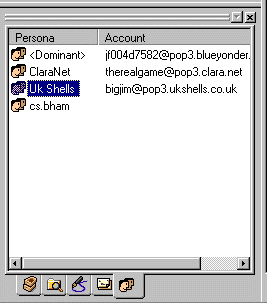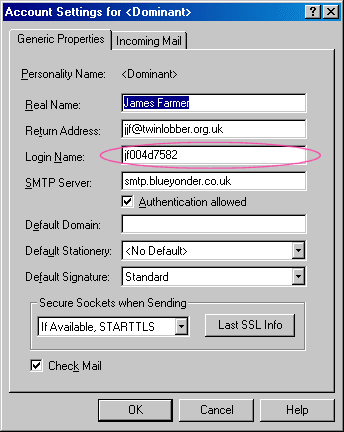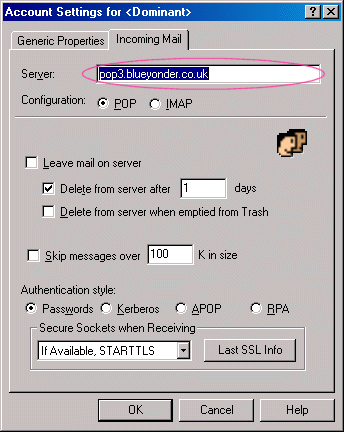This page gives instructions
on installing and setting-up SpamPal for use with the e-mail client
program,
Eudora |
|
1. Install
SpamPal
2. Configure
SpamPal
3. Configure
your email program
3.1 Change your POP3 settings
3.2 Change your IMAP4 Settings
3.3 Change your SMTP settings
3.4 Create Filter/Message rules
4. Email
Virus Scanners and Firewalls
5. Whitelist
friends and contacts
|
|
Start installation by double-clicking on the SpamPal
Setup program (spampal.exe) and follow
the on-screen instructions. Upon completion, SpamPal will run, showing
its pink umbrella icon in your system tray.
If this installation is an upgrade of SpamPal
then the existing configuration of Eudora is retained and the process
is now complete. If not, i.e. this is a new installation of SpamPal,
proceed with the steps below.
|
::Top:: |
| All
you need to know about extra configuration can be found here |
::Top:: |
Now
you have set up SpamPal, you need to tell your email program to fetch
your mail through the SpamPal proxy rather than directly from your
ISP.
You need to how you collect mail from your ISP, for example, if you
use POP3 to collect your mail then your only need to change your POP3
settings. |
::Top:: |
Load Eudora,
then select Personalities from the Tools
menu to bring up the personalities box, e.g.:
Now, write down the name of your POP Server
in the POP Server box (e.g..pop3.yourisp.com)
and
then replace this with 127.0.0.1 |
|

|
|
Now, for the first personality (most people will
only have one), right-click on it and select Properties.
You'll get a window with two tabs that look a bit like this:
|
  |
| You
can access these options from the Getting Started screen
of the Options window (accessible from the Tools
menu). |
|
|
I've highlighted the two fields
we'll need to alter in pink. Firstly, go to the login name field,
and add a '@' to the end of the current
login name. After the '@', type what's
in the Server field of the incoming mail
tab. Now go to the server field
and type localhost.So, in the
example above, I ended up with:
|
|
|
|
Now add an @ symbol and
the POP
Server name that you wrote down earlier, to the Username
logon box
(e.g.. my_login_name@pop3.yourisp.com)
You should also ensure your email address is entered correctly
in the Return Address: box. Importantly,
do not leave this blank - if it's blank then Eudora will
guess your email address based on your username and servername,
but when using SpamPal it will guess it wrong (and you'll end up
with an address like jjf@twinlobber.org.uk@localhost).
|
You
may, at this point, get an error message about SpamPal not being
able to listen on the standard POP3 port.This is nothing to
be worried about; just write down the port number SpamPal tells
you and continue with this guide
This message means SpamPal is using Port 1110
instead of 110.
You don't have to put it into SpamPal because SpamPal already
knows it is using port 110.
Instead, you have to tell your email program to use port 1110
instead of 110.
|
|
| Don't
worry; just add @localhost to the username and leave the server
name as is |
|
| continue
regardless; SpamPal copes with usernames that contain two @s
without difficulty. |
|
| Append
the port number to the server name in the login name field
using a colon. For example, if BlueYonder ran their POP3 server
on port 8090, I'd end up with a login name of jf004d7582@pop3.blueyonder.co.uk:8090
|
|
| Now click
OK to confirm, and repeat this for
all the remaining personalities. |
| This
is a little tricky, for which you can thank the fine people
who wrote Eudora. You need to close Eudora, then open Windows
Exporer and go to it's installation directory (usually C:\Program
Files\Qualcomm\Eudora). Go into the subdirectory extrastuff,
select esoteric.epi and click copy (or select Copy from the
Edit menu). Now, go up one directory level (so you're in Eudora's
installation directory again) and click Paste (or select Paste
from the Edit menu).
Now start
Eudora. From the Tools menu select Options.
At the bottom of the list of categories you will find one
labelled Ports - select this, then change the POP3
Port field from 110 to whatever value SpamPal told you
when you installed it.
|
|
| Now try to
check your mail; if you don't get any errors, continue to the next
step. You may be asked to re-enter your POP3 passwords; this is nothing
to worry about. If you get an error from Eudora, check that you've
configured the incoming POP3 server to localhost
and, if necessary, that the port has been set right. If you get an
error from SpamPal, check you've added the servername to the username
correctly, and that your Internet connection is active. |
|
In all likelihood, this is because
your outgoing mailserver requires a username and password,
and Eudora always uses the same one as you've configured for
your incoming mailserver - which you've just changed to use
with SpamPal. Eudora's official
solution to this problem is to create a separate personality
for sending email.
However, provided you only use one
incoming mailserver, there is an alternative. Go into SpamPal's
Options window and click on the Servers tab.
Change from Mailservers specified
in POP3 usernames to Mailservers
specified in SpamPal.
Click on the Add New Mailserver button and type in
the address of your incoming (POP3) mailserver.
Click OK a couple of times,
then go back into Eudora and remove the extra stuff you added
to your username - i.e. if you'd changed joe
to joe@pop.aol.com, change
it back to joe. Leave
the incoming server name as localhost,
however.
Try it now; it should work!
|
|
|
| Incoming
Mail (POP3):mail.btopenworld.com |
Incoming
Mail (POP3): 127.0.0.1 |
| Username: fred.bloggs |
Username: fred.bloggs@mail.btopenworld.com |
| Incoming
Mail (POP3): pop.west.cox.net |
Incoming
Mail (POP3): 127.0.0.1 |
| Username: johnsmith |
Username:johnsmith@pop.west.cox.net |
| Incoming
Mail (POP3): pop.telus.net |
Incoming
Mail (POP3): 127.0.0.1 |
| Username: fax07734 |
fax07734@pop.telus.net |
| Incoming
Mail (POP3): 192.168.1.1 |
Incoming
Mail (POP3): 127.0.0.1 |
| Username: mary_jones |
Username: mary_jones@192.168.1.1 |
|
The
above Incoming POP3
Server Name, can be called:
Incoming Mail Server,
POP3 server, POP3 Username or Account Name depending on your
email program.
There are also two ways of specifying the local
server name, which should mean exactly the same thing (but on
some system only one of them will work): localhost
or 127.0.0.1 |
|
| If you are still having a problem,
why not give this setup page a
try |
::Top:: |
|
Coming
Soon...
|
::Top:: |
| Coming Soon... |
Now, take
a note of your current SMTP Email Server,
for example: smtp.myisp.co.uk
Now change the current SMTP Email Server,
to: 127.0.0.1
Now go to SpamPal's Connections
page: |
|
|
|
Now click on Add port and change
the Port Type to SMTP
Now, change the Server Name to
the SMTP server name you noted down earlier, e.g..smtp.myisp.co.uk
|
|
|
| Now, whenever
you send an email, SpamPal will automatically auto-whitelist it |
Occasionally,
a spammer might forge the email address of someone who is
in your auto-whitelist - for example, a colleague or an alternate
email address or yours. While you don't want to put this
person
in your blacklist because they send you lots of genuine email,
you don't want them to end up in your auto-whitelist and
bypass
SpamPal's spam-checking features.
Clicking on the Exclusions
pane will bring up a window into which you can enter the email
addresses of people who should never be added to the auto-whitelist.
Just add your colleagues here and you won't have to worry
about spammers forging their addresses to bypass SpamPal's
filtering. You can even add your entire employer's domain
- e.g. *@acme-widgets.com |
|
::Top:: |
If you are are
using an IMAP4 server, you
will not need to setup a filter/message rule on your email program,
as SpamPal moves any spam tagged messages automatically into a folder called inbox.spamtrap on
your
server.
If you are are using a POP3 server
and want your email program to automatically filter the SpamPal-marked messages
into a separate Mailbox, so that you can more easily review them, continue
as follows |
Select Filters
from the Tools menu to call up the Filters
window. On the left of this window is the list of all your filters;
to the right is the area where you create filters. Click New
to create a new filter.
In the first Header:
field on the right, type X-SpamPal:,
and in the box next to it type SPAM.
Now go down to the Actions
area. From the first drop-down list, select the action Transfer
To. Click the box that appears to the right of this, select
New... and into the dialog that appears
type spamtrap. Click OK
to confirm this.
Now, in the second Actions
drop-down list, select Skip Rest.
The screen should look something like this:
|
|
|
|
This will create a filter that will move anything
that SpamPal thinks is spam to a folder called spamtrap.
If you have any other filters set up, click on the new filter in
the list on the left and drag it to the top of the list, so that
it takes priority over everything else.
Close the window and make sure you answer Yes
when asked if you want to save the filters
|
::Top:: |
|
Specific instructions for using a variety of email
virus scanners with SpamPal can be found on the main
installation page
Some email virus filters want to sit between your
mail program and your mail server in just the way that SpamPal does.
There's actually no reason why they can't; you just have them up
in serial so that your virus filter fetches its mail through SpamPal
rather than directly from your mailserver, and then your email program
fetches the mail through the virus filter.
|
::Top:: |
|
In order to speed up the processing of your emails
and to prevent SpamPal from marking your friends or contact's emails
as spam, it's a good idea at this point to whitelist all your important
email addresses.
This can be done in four ways:
a) Use the pop3
automatic whitelist: this will whitelist non-spam
email's that you receive on a frequent basis
b) Use the smtp
automatic whitelist: which (if setup in 3.3)
will whitelist all email addresses that you send out
|
| If
you are using this, especially in a business, as this is recording
all outgoing addresses, some people might view this as an infringement
upon their privacy, (if you are in UK you need to tell staff
of this policy before you start collecting data) |
|
|
c) use
the Add to Whitelist option on
SpamPal's system tray: to manually
whitelist your email addresses by typing in an address (or by using
the dropdown box; to select from a list of recently received address):
|
|
|
| d)
Use the SpamPal Whitelist
Email Addresses page to manually
whitelist your email addresses: |
|
|
The
whitelist function only looks for email addresses in certain
headers of your email.
These headers are currently: From:,
Reply-To:,
Sender:, Mailing-List:
and Return-Path: |
|
|
Initially,
you will notice that using SpamPal makes fetching your email a little
slower. This is because SpamPal has to check everything against
the DNSBL lists (Public Blacklists) to see what email's are from
a spammer and which aren't.
However,
through it's Auto-Whitelist feature(s), SpamPal will quickly learn
about the people and machines that send you lots of email, and adds
them to a list of trusted senders. Because they're trusted, SpamPal
doesn't waste time any checking the DNSBL lists (Public Blacklists)
for them and so the more you use SpamPal, the quicker it will get.
There are more hints and tip on how to optimise SpamPal here
|
| This completes
the installation and setup. |
::Top:: |